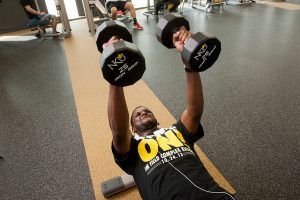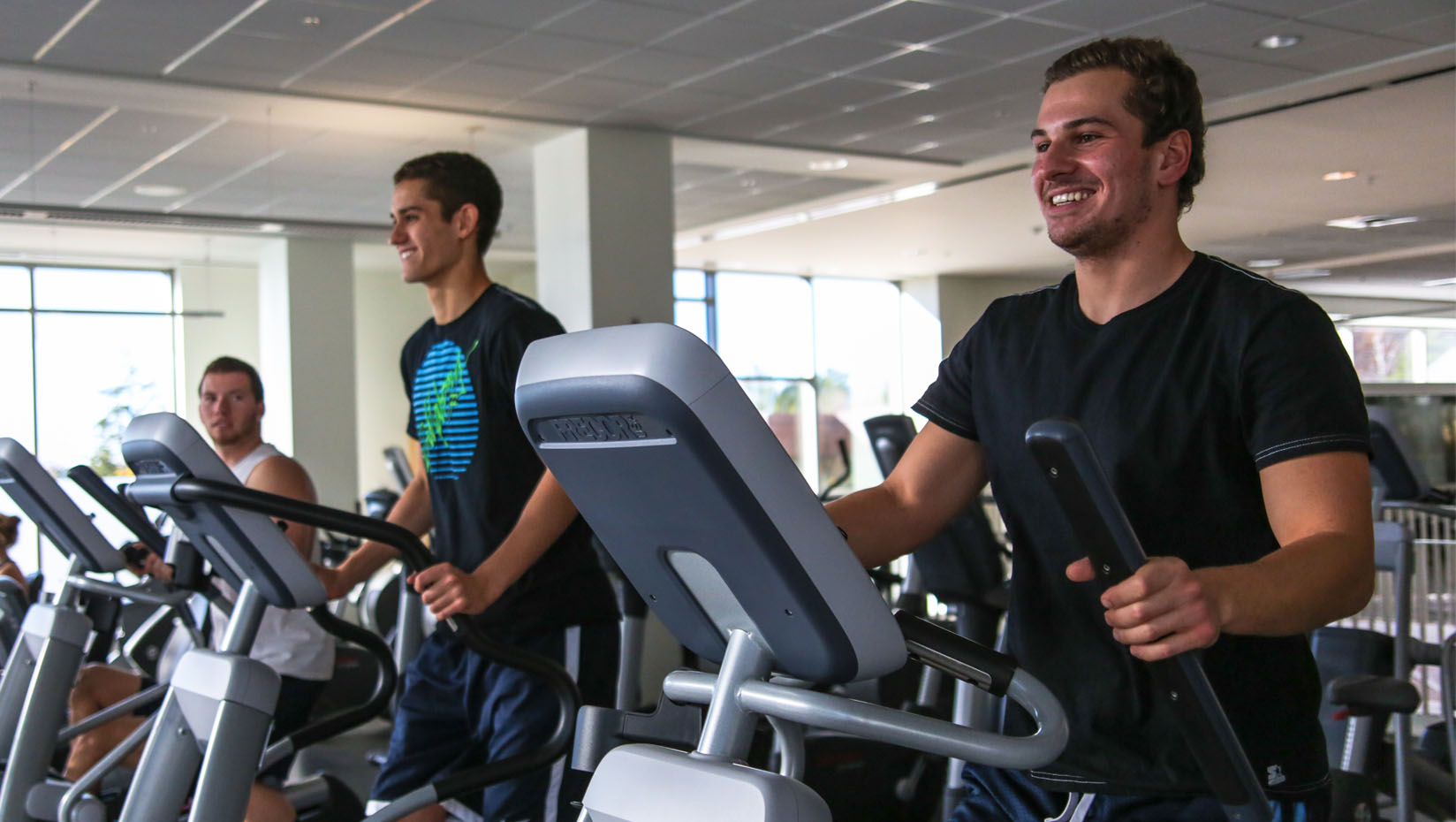Adopting a Fit Fam
Weighing the pros and cons of exercising with friends.
By Andrew Mikula, Bates College
Your typical college fitness center can be a bizarre place.
Some people need to utter every single curse word in the English language before they can muster the strength to lift the barbell above their heads. Others are performing yoga moves so dynamic that they whack you in the face several times, so entrenched as they are in their spiritual ambient music that they hardly notice. And everyone dreads hearing the consistent groans of hardcore dumbbell junkies…except, well, hardcore dumbbell junkies. Basically, college fitness centers are no different from any other gym, with the exception of one small feature.

Many college students go to the gym in teams, whether athletes of organized Division 1 sports or a couple of friends looking to stay fit. Apparently, having a friend present is an effective way of amusing yourself without having to blast your music over the sound of crashing weights.
Still, despite the boosted productivity, there’s ample cause to be skeptical about how successful working out with others will be, and this lapse in productivity is relevant whether you’re working on your six-pack or jogging through the snow (although the latter is probably a terrible idea, assuming you didn’t want to slip and end up in the hospital).
No matter your method of getting ripped though, having some friends around can help you tackle the initial loneliness that sets in when you’re in the gym early in the morning, hungry and tired, with no motivation and broken headphones. Surprisingly, it might even help keep you in shape as well. In groups, friends can help push each other to new limits, facilitating a sense of competition and motivation.
On the other hand, it’s also possible that one member of the group slows the others down. To deal with that possibility, try starting a new workout together, that way all the team members are on a level playing field.
Whether your group is all on the same level—or strength, or grunt magnitude—though, they’re still objects of socialization. A dreary morning at the fitness center can suddenly feel more like a night of partying (minus the alcohol, but with an equal amount of sweat), when you’re with your friends. And certain exercises are safer when performed in groups, such as having a spotter for heavy lifting or a running partner in shadier areas. At the very least, a friend would be able to help you get back to your dorm in the event that you get injured.
But, just like doing homework with other people, it defeats the purpose if going to the gym completely revolves around chatting with your friends.
Either way, why would you work out at all when you could be playing a sport? Organized events promise the thrill of competition, companionship and fun, often granting the added benefit of new friends. In an age when varsity sports are extremely time-consuming and competitive, intramural athletics offer a more casual alternative. And if intramural sports sound like a big commitment, many colleges provide state-of-the-art facilities and equipment for student use. That way, all you need is a friend with a car, and weekend trips to ski lodges, golf courses or skateboard parks become both convenient and enjoyable.
Depending on the college though, simply getting around campus can be a good form of exercise. Bicycles, skateboards and scooters are common sights between classes.
I even have a friend who, instead of gaining 15 pounds, lost 10 her freshman year, which she attributed to her school’s sprawled-out, hilly campus.
Unfortunately, human-propelled modes of transportation might prove impractical or even dangerous during the winter months. I’ve never tried skiing to class myself, but my guess is it’s not entirely rewarding.
Besides, exclusively playing specific sports or relying on walking to burn calories won’t cover all of your muscle groups. Going out dancing on weekends can also serve as exercise to an extent, but flexibility and strength training are still important. Dancing usually prioritizes socialization over fitness anyway.
Keeping fitness as your primary goal might entail figuring out an exercise method that works for you before including others. And it’s easy to be excited about sharing a program or routine with your friends, but having others adjust to your workout plan often requires patience. After P90X made me feel more confident and energetic than I’ve been in years, I was disappointed that my friends couldn’t keep up with me, sparking resentment and patronization. I had forgotten that, just a few months before, I was greatly struggling with the workouts myself.
On the other hand, reaping the benefits of working out in groups requires flexibility (and not just the physical kind). Sometimes enjoying your friends’ company at the gym requires being open to novel forms of exercise. Compromise itself fuels friendship. If you only like lifting weights, and your friend only does cardio, why not step into each other’s worlds on occasion? This variety is also a good way of making sure you get plenty of both aerobic and anaerobic exercise, assuming the gym doesn’t kick you out for grunting too loud.
Moreover, no one is pretending that working out in groups doesn’t have potential drawbacks. But after a rewarding workout in good company, not only will your friends thank you, but your body will too.


















[…] and immersive experience. Until the final track comes to a close, you won’t feel like you’re at the gym. You’ll be (mentally) clinging to ledges and rappelling down buildings all the […]